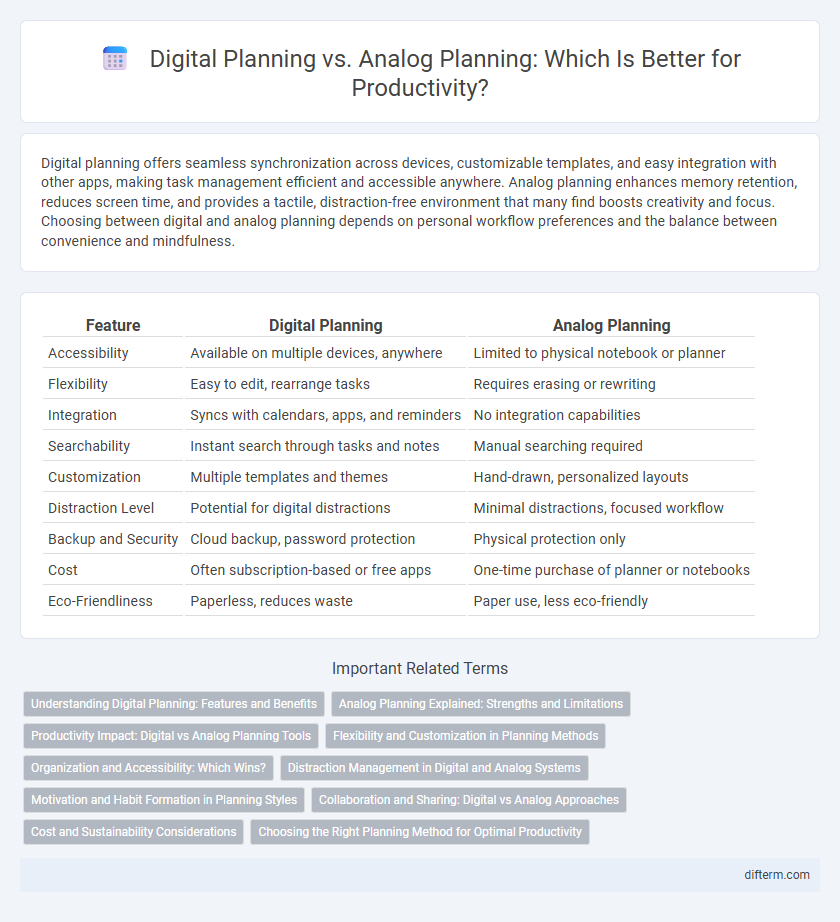Digital planning offers seamless synchronization across devices, customizable templates, and easy integration with other apps, making task management efficient and accessible anywhere. Analog planning enhances memory retention, reduces screen time, and provides a tactile, distraction-free environment that many find boosts creativity and focus. Choosing between digital and analog planning depends on personal workflow preferences and the balance between convenience and mindfulness.
Table of Comparison
| Feature | Digital Planning | Analog Planning |
|---|---|---|
| Accessibility | Available on multiple devices, anywhere | Limited to physical notebook or planner |
| Flexibility | Easy to edit, rearrange tasks | Requires erasing or rewriting |
| Integration | Syncs with calendars, apps, and reminders | No integration capabilities |
| Searchability | Instant search through tasks and notes | Manual searching required |
| Customization | Multiple templates and themes | Hand-drawn, personalized layouts |
| Distraction Level | Potential for digital distractions | Minimal distractions, focused workflow |
| Backup and Security | Cloud backup, password protection | Physical protection only |
| Cost | Often subscription-based or free apps | One-time purchase of planner or notebooks |
| Eco-Friendliness | Paperless, reduces waste | Paper use, less eco-friendly |
Understanding Digital Planning: Features and Benefits
Digital planning offers dynamic features such as synchronization across devices, customizable templates, and real-time collaboration, enhancing productivity and organization. Automated reminders, goal tracking, and integration with apps streamline task management, reducing manual effort and increasing efficiency. These benefits enable users to adapt quickly to changing schedules and maintain a consistent workflow, outperforming traditional analog methods in flexibility and scalability.
Analog Planning Explained: Strengths and Limitations
Analog planning enhances productivity by offering tactile engagement and reduced digital distractions, allowing for better memory retention and focus through handwritten notes. Its limitations include less flexibility for quick edits, difficulty in sharing or collaborating in real-time, and the need for physical storage space, which can hinder scalability. Many users find analog tools like paper planners and bullet journals ideal for fostering creativity and mindfulness but less efficient for integrating with digital workflows.
Productivity Impact: Digital vs Analog Planning Tools
Digital planning tools enhance productivity by offering real-time synchronization, easy editing, and integration with other apps, enabling efficient task management and faster adjustments. Analog planning methods improve focus and memory retention through tactile engagement and reduced screen distractions, supporting deeper cognitive processing. The choice between digital and analog planning significantly affects productivity outcomes depending on individual preferences and specific task requirements.
Flexibility and Customization in Planning Methods
Digital planning tools offer unparalleled flexibility with customizable templates, real-time updates, and seamless integration with calendars and task management apps. Analog planning allows for tactile customization through handwritten notes, doodles, and personalized layouts, fostering creativity and memory retention. Users often prefer digital tools for dynamic adaptability, while analog methods excel in personalized expression and reduced digital distractions.
Organization and Accessibility: Which Wins?
Digital planning offers superior organization with features like searchable calendars, cloud synchronization, and task prioritization, making it easier to manage complex schedules efficiently. Analog planning provides tactile engagement and visual clarity through physical layouts, but lacks quick accessibility and real-time updates. For seamless accessibility and dynamic organization, digital planning ultimately outperforms analog methods.
Distraction Management in Digital and Analog Systems
Digital planning tools often include integrated features such as notifications and multitasking capabilities that can increase distractions, requiring users to actively manage interruptions to maintain focus. In contrast, analog planning systems, like paper planners, minimize digital interruptions by providing a tactile and screen-free environment, which naturally reduces exposure to notifications and online distractions. Choosing between digital and analog planning depends on individual distraction management preferences and the ability to leverage each system's strengths to enhance productivity.
Motivation and Habit Formation in Planning Styles
Digital planning enhances motivation by providing real-time tracking and customizable reminders that reinforce habit formation through consistent engagement. Analog planning fosters deeper cognitive processing and emotional connection, which can strengthen habit development by making goals feel more tangible and personal. Combining digital tools with analog methods often yields the highest motivation and sustained habit formation in productivity planning styles.
Collaboration and Sharing: Digital vs Analog Approaches
Digital planning enhances collaboration and sharing by offering real-time access, seamless updates, and easy synchronization across devices, enabling teams to coordinate efficiently regardless of location. Analog planning methods rely on physical materials like paper, which limits immediate sharing and requires manual distribution, slowing down collaborative efforts. Digital tools also integrate communication features such as comments and task assignments, significantly improving team productivity and transparency compared to traditional analog systems.
Cost and Sustainability Considerations
Digital planning reduces costs by eliminating paper, ink, and printing expenses, while offering reusable and easily editable tools that enhance long-term sustainability. Analog planning incurs recurring costs for notebooks, pens, and physical storage, generating more waste and environmental impact. Choosing digital methods supports eco-friendly productivity by minimizing resource consumption and enabling efficient task management.
Choosing the Right Planning Method for Optimal Productivity
Digital planning offers dynamic flexibility with features like real-time synchronization, task automation, and cloud accessibility, enhancing productivity for tech-savvy users. Analog planning, favored for its tactile engagement and reduced digital distractions, improves memory retention and creative ideation. Selecting the right method depends on individual workflow preferences, with hybrid systems often maximizing efficiency by blending digital precision and analog intuition.
Digital planning vs Analog planning Infographic

 difterm.com
difterm.com